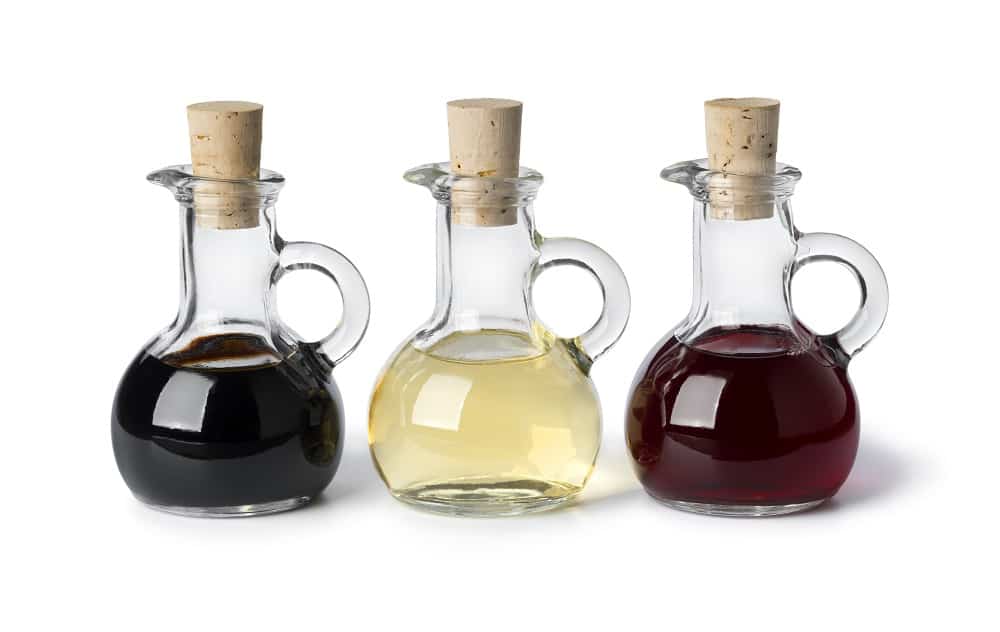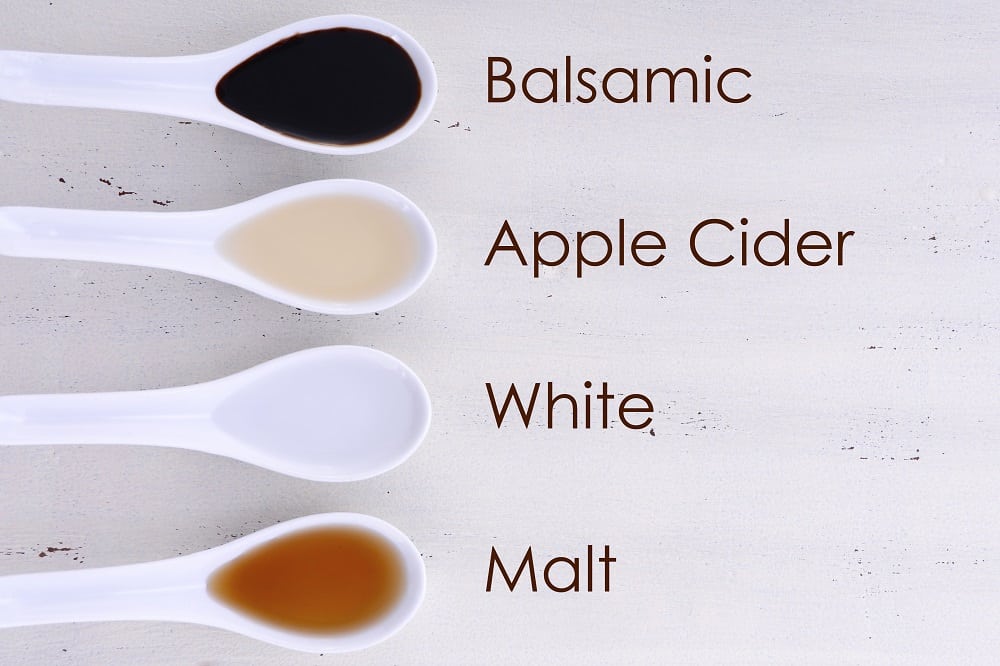Vinegar is a fermented food product that has been assumed to exist earlier than historical records. The acidic solution is used as an ingredient to many different products, but it can also be used as a stand-alone condiment. Vinegar is used all over the world and can exist in many different forms. Aside from adding flavor, vinegar is also used as a preservative due to its low pH.
Vinegar is considered to be suitable for vegans as the ingredients and production of vinegar do not typically involve animal products or derivatives. However, there are some instances when vinegar is not vegan (e.g., when they use animal products as raw materials such as honey vinegar, when animal products such as isinglass are used in vinegar production, etc.)
Table of Contents
Vinegar

Along with other fermented food products, vinegar has a long history in cultures around the world. Distinctly acidic due to its acetic acid content, vinegar is a seasoning used worldwide for both its usefulness and versatility (1).
Vinegar is commonly used to add flavor to meat and vegetables. It is also a common ingredient in salad dressings and various sauces. Used on its own, vinegar can be used as a condiment for cooked vegetables, meat, and fish.
Dating earlier than historic records, it is assumed that vinegar existed as early as the existence of alcoholic beverages such as beer and wine because these alcoholic beverages would have turned to vinegar when left exposed to the air.
Aside from being used as a condiment and ingredient, vinegar is also commonly used as a preservative. The high acidity of vinegar makes it difficult for bacteria that are responsible for spoilage to grow. Specifically, vinegar is used in pickling a wide variety of food items such as fruits, vegetables, meat, and fish.
Vinegar also has a long history of being used for medicinal purposes. It was said Hippocrates, often called the Father of Medicine, used vinegar to manage wounds in Ancient Greece. Many other writings throughout history and different cultures list vinegar to be used to treat a wide array of symptoms including poison ivy, croup, stomachaches, and even diabetes (2).
Is Vinegar Vegan?
Generally, vinegar can be considered vegan – especially when referring to traditional vinegar as the raw materials used to produce vinegar do not include any animal product or derivative. Raw materials used for vinegar production are typically plant-based such as apples, grapes, barley, and rice.
However, there are certain scenarios when vinegar is non-vegan.
For one, honey vinegar is not vegan because it uses honey as a raw material. However, animal-derived vinegar such as this is not common.
Second, industrially produced vinegar might be non-vegan when they introduce animal products or derivatives in the ingredients or in the production process. Some companies use isinglass (i.e., collagen derived from the swim bladders of fish) to clarify vinegar and make it more appealing to the market.
Vinegar Production
Traditionally, vinegar has been produced from weak alcoholic products. The etymology of vinegar itself comes from the old French vinaigre which means “sour wine.”
By convention, vinegar is produced through a process called double fermentation. This is because vinegar production is composed of two distinct fermentation steps.
The first step in making vinegar is through the fermentation of raw materials into alcohol, typically with the help of yeasts. The single-celled fungi break down the sugar in the raw materials and convert them into ethanol. This step is usually done in the absence of oxygen.
After the raw materials have been broken down and converted into alcohol, the medium undergoes a microbial ecological succession. This means that the solution that was once conducive to yeasts has now shifted to promote the growth of certain bacteria that are able to grow in this alcohol-containing medium.
The succession brings about bacteria from different genera such as Acetobacter and Gluconacetobacter to convert the alcohol into acetic acid. This constitutes the second fermentation phase. These bacteria are suitable for this step as they are able to perform the conversion of ethanol to acetic acid and tolerate the increasing concentrations of acetic acid in the medium.
The production of vinegar can take a long time, especially when the process is left to obtain the microorganisms naturally from the air. However, the process can also be sped up when cultures of microorganisms (or the “Mother of vinegar”) are intentionally inoculated into the mixtures to speed up the fermentation processes.
Types of Vinegar

There are many different types of vinegar in the world that exhibit different properties such as flavor, acidity, aroma, and general usage. The principal difference among them is the raw material fermented to produce them. Also, the type of vinegar is usually associated with the country where it is produced. Here are some of the more common types of vinegar that one could probably see in the vinegar aisle at the supermarket.
White Vinegar
With a characteristic sharp and pungent profile, white vinegar is among the most used type of vinegar in the US. It is typically produced using grain alcohol as its raw material. If the alcohol used is distilled, then it would produce distilled white vinegar.
Balsamic Vinegar
Compared to white vinegar, balsamic vinegar has a zesty and mild profile attributed to its raw material: grapes. Balsamic vinegar comes with a dark color and is used in many Italian dishes as this type of vinegar originates from Italy.
Apple Cider Vinegar
Tart and fruity, apple cider vinegar is made from fermented apple juice. This type of vinegar has become popular for its many purported health benefits (e.g., lowers blood sugar, improves insulin sensitivity, lowers cholesterol, etc.).
Wine Vinegar
As the name suggests, wine vinegar is made by fermenting wine. Wine vinegar can be produced from both white wine and red wine to make white wine vinegar and red wine vinegar, respectively. The taste of the two is distinct as white wine vinegar is sweet and mild while red wine vinegar is tart and salty.
Malt Vinegar
Using the same raw materials as beer, malt vinegar can be produced by fermenting the grains of barley. Producing a dark brown vinegar with a toasty and rich flavor profile, malt vinegar is commonly used in making sauces, brines, and marinades as it pairs well with sugar as it effectively balances out the sweetness.
Rice Vinegar
Originating in Asia, it comes as no surprise that rice vinegar is a staple in many Asian dishes. Produced from fermented rice, rice vinegar is considered to be sweet and delicate and is commonly used in pickled vegetables, salad dressings, and more.
References




